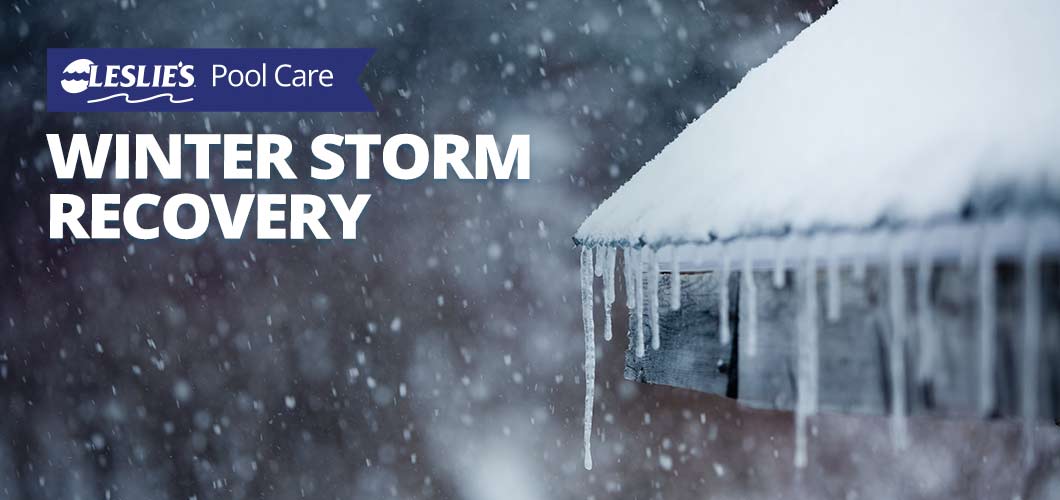
Pool Recovery After a Winter Storm
When we think of pool recovery, we don’t often think of winter storms and weather events. After all, the pool is closed! For many pool owners the pool surface is covered, the water is at least partially frozen, and the pool equipment has been drained for the off season. What’s to worry about?! (If your pool isn't closed, that's another story; more on that below.) The truth is, there are a few things to consider when it comes to your pool and severe winter weather.
In short, the main things you should be concerned about during a winter weather event are:





We’ll walk you through the basics of winter storm recovery to make sure your pool gets through winter unscathed. And if something does happen, we’re here to help. Follow these tips to make sure you’re not left with a big mess to clean up in the spring.
Heavy Snow
Excessive snowfall can be a problem for any pool owner, even if you have a mesh cover on your pool. The problem with snow is that it’s essentially an expanded form of solid water. Until the snow melts, it can’t pass through a mesh cover. You also can't remove it from solid covers with a cover pump until it's melted.
An inch or two here and there is nothing to worry about. But 6, 8, 10, or even 12+ inches of snow accumulation can become a problem in a hurry. Think about the sheer volume of water sitting on top of your pool, and how much extra stress that weight is putting on the edges of the pool cover. If the stress becomes too much for your cover, there’s a very real possibility that it could fail. You don't want the cover ripping and falling into the pool! When this happens, you'll have an even bigger problem on your hands.
SAFETY TIP: DO NOT step out onto the pool cover to remove snow. Even if you think the surface of the pool is frozen, walking on your cover can quickly become a safety hazard. It’s best to just remove the snow from the edge of the pool, with your feet firmly planted on the pool deck.
The best way to deal with heavy snow on the cover is to be proactive about it. Just like you clear your sidewalk and driveway in front of your home after a winter storm, for pool recovery, it’s important to remove excess snow accumulation from your cover to avoid future problems. There are a couple different ways you can do this.
If the snow is light, dry, and fluffy, you may be able to remove it with a leaf blower. Unfortunately, this doesn’t work if the snow is more than a couple inches thick, or if it’s really wet and heavy snow. Another method is use a soft push broom to push/pull the snow off the cover. If you don’t have a broom with a long enough handle, you can also use a leaf rake and telescoping pool pole to scoop the snow away. It doesn’t have to be a perfect job. Your main goal here is to remove as much of the extra weight from the cover as you can.
Ice
Ice storms and freezing snowmelt bring their own set of unique challenges to pool owners. If you live in freezing conditions, ice is inevitable. The important part is to make sure the ice doesn’t get unmanageable or threaten the integrity of your pool cover.
As we talked about in the previous section, it’s important to remove excess snow so it doesn’t contribute to your ice problem. When possible, use a cover pump to remove the water as it melts naturally.
Being proactive to prevent ice buildup is the best way to moderate it. Once you have the ice, you’re kind of stuck with it. Never try to melt the ice on your own, or you could damage the cover. You also don’t want to crack or break the ice to try and remove it. Broken ice has sharp edges, and the thicker or heavier the ice is, the more likely your cover will tear because of it. If it's firmly frozen to the cover, you risk further rips.
BONUS TIP: Ice on the cover is more dangerous if it’s shifting around. Check your pool’s water level at least once or twice a week to make sure there are no undetected leaks. A dropping water level increases the risk of your pool cover tearing under a heavy load of ice and snow.
Fallen Limbs
After an ice storm or blizzard, chances are pretty good that there will be at least a few fallen twigs and tree limbs in your yard. If any limbs have fallen onto the pool cover, carefully remove them, and check to see if there is any cover damage. If so, make an immediate plan to either repair the cover or replace it. Here’s a quick checklist to help you decide:
- Is the rip or tear larger than a dollar bill?
- Are there multiple rips or tears in the cover?
- Is the cover showing other signs of wear and tear?
- Is the cover outside of the warranty period?
If you answered YES to any of these questions, you should probably invest in a new pool cover. The only exception to this rule would be with a safety cover. You might choose to pay an industrial seamstress to completely replace the damaged cover panels. Just be aware that extensive repairs like this can be quite pricey and/or have a long turnaround time. Sometimes it just makes more sense to get a new pool cover, which makes your winter storm pool recovery much easier
If large limbs fall and cause a complete cover failure, or if storm debris is introduced to the pool water, you’ll need to take extra measures to keep the pool from becoming a swampy mess by springtime. First, remove as much of the debris as you possibly can. Then check the pool’s water balance as soon as you’re able to, which will point out chemistry problems before they become a bigger issue. Serious water balance issues could mean you'll have to open the pool a few weeks earlier than usual. You can always bring a water sample to your local Leslie's store for advice and a free AccuBlue® water test, which is more accurate and reliable than an at-home test kit or test strips. Finally, add more sanitizer to help combat potential issues. You can use a pool brush to help agitate the water and distribute the sanitizer. Aside from sanitizers, avoid adding water balancing chemicals until the circulation system is reconnected; doing so may harm pool surfaces.
High Winds
High winds and falling tree branches often go hand in hand, especially during icy conditions. Blustery weather can also wreak havoc on your pool cover if it’s not secured properly. When winter storms are in the forecast, make sure that your water tubes or blocks are still full, in good shape, and securely fastened to the cover. If you have an above ground pool, ensure that the cable is tight, and tighten the winch if needed. With a safety cover, check to see if all of the straps and buckles are snug and secure. These precautionary steps will help prevent the wind from whipping your cover around, and it will also protect your pool against objects blowing in the wind.
Unexpected Freezing Temperatures
As mentioned above, most severe winter storms and events occur in places where it's expected and pools are closed. If by some chance you are dealing with extreme winter conditions — including unexpected freezing temperatures — and you haven’t closed your pool, there are important actions that need to be taken, in addition to properly covering your pool.
The safest option is to turn off all equipment at the breakers and drain your equipment. For steps on how to properly execute this, and for additional options when power is and is not available, check out our blog post on How To Respond to Freezing Weather Conditions in Your Pool.
Having off-season pool troubles? Whether it’s cleaning the pool and repairing damage after a winter storm, or troubleshooting the source of a water leak, we can help. Speak with one of our knowledgeable associates for the best winter pool care advice. Give us a call or stop by your local Leslie’s store today. And remember, swimming season is right around the corner. The cold, snow, and ice will soon be a distant memory!